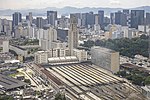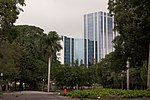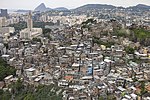April 2010 Rio de Janeiro floods and mudslides

The April 2010 Rio de Janeiro floods and mudslides was an extreme weather event that affected the State of Rio de Janeiro in Brazil in the first days of April 2010. At least 212 people died, 161 people have been injured (including several rescuers), while at least 15,000 people have been made homeless. A further 10,000 homes are thought to be at risk from mudslides, most of them in the favelas, the shanty towns built on the hillsides above downtowns. Damage from the flooding has been estimated at $23.76 billion reais (US$13.3bn, €9.9bn), about 8% of the gross domestic product (GDP) of Rio de Janeiro State.The flooding particularly affected the city of Rio de Janeiro, where at least 60 people died, and its surrounding area. Deaths were also reported in the cities of Niterói (132), São Gonçalo (16), Paracambi (1), Engenheiro Paulo de Frontin (1), Magé (1), Nilópolis (1) and Petrópolis (1). Several municipalities, including Niterói and municipalities to the east such as Maricá and Araruama, have declared states of emergency or of public calamity. The Governor of Rio de Janeiro State, Sérgio Cabral, declared three days of official mourning for the dead. Heavy rain started at around 5 p.m. local time (2000 UTC) on Monday April 5th in Rio de Janeiro city, and continued for 24 hours, with a total of 28.8 cm (11½ in.) of rain falling, more than was predicted for the whole of April and the heaviest rainfall for 30 years. The Brazilian TV station Globo said the rainfall was equivalent to 300,000 Olympic swimming pools of water. There were drivers who were forced to sleep in their cars. There were also firemen who used rubber dinghies to rescue passengers from stranded buses, and shopkeepers who worked very quickly to prevent the rainfall from destroying their businesses.Rio de Janeiro mayor Eduardo Paes admitted that the city's preparedness for heavy rainfall had been "less than zero," but added "there isn’t a city that wouldn’t have had problems with this level of rainfall."A further landslide hit a slum in Niterói late on April 7. It is thought to have killed at least 150 people. Around 200 people were missing in the town as of April 13th, 2010.After nearly 300 landslides hit the area, the statue of Christ the Redeemer was cut off from traffic for the first time in history.More than 300 homes were bulldozed after the landslides, and it is estimated that close to 12,000 families will need to be relocated by 2012 due to the damage from the floods.
Excerpt from the Wikipedia article April 2010 Rio de Janeiro floods and mudslides (License: CC BY-SA 3.0, Authors, Images).April 2010 Rio de Janeiro floods and mudslides
Avenida Trinta e Um de Março, Rio de Janeiro Centro
Geographical coordinates (GPS) Address Nearby Places Show on map
Geographical coordinates (GPS)
| Latitude | Longitude |
|---|---|
| N -22.908333333333 ° | E -43.196388888889 ° |
Address
Avenida Trinta e Um de Março (Avenida 31 de Março)
Avenida Trinta e Um de Março
20230-250 Rio de Janeiro, Centro
Rio de Janeiro, Brazil
Open on Google Maps








